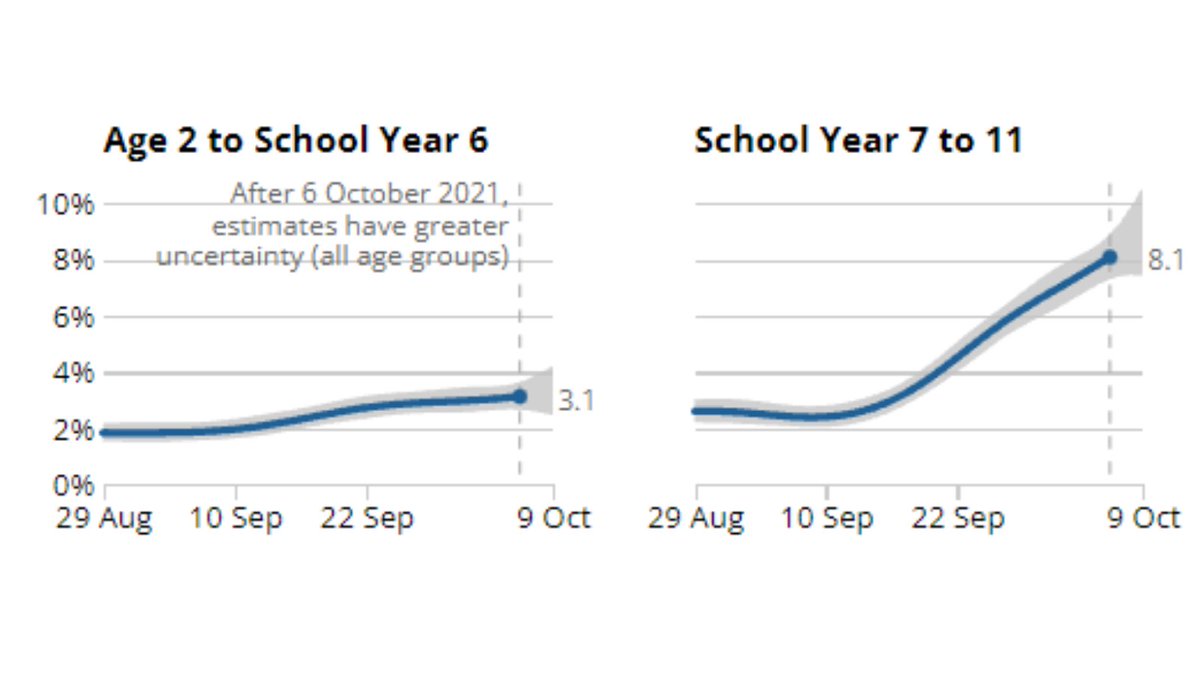
Time for a quick round up of the bizarre world of #COVID19 epidemiology in children in England right now
Hold on to your hats, it's an interesting picture and despite what you might have heard, it's not all bad news! 🧵
1/
Hold on to your hats, it's an interesting picture and despite what you might have heard, it's not all bad news! 🧵
1/
Firstly @UKHSA clinical cases
Case ballooned in secondary school age children after a blip on school opening, and after a slight dip (?) now up again
Primary children appeared to continue summer trend upwards, with small school re-entry blip. Now maybe oscillating or up?
2/
Case ballooned in secondary school age children after a blip on school opening, and after a slight dip (?) now up again
Primary children appeared to continue summer trend upwards, with small school re-entry blip. Now maybe oscillating or up?
2/

This trend is matched by school ages in the @ONS population sampling data
Huge prevalence last week in secondary school age (>8%!), and less than half of this in primary school age
Remember we've been saying for 18m young children are different to older children?
3/
Huge prevalence last week in secondary school age (>8%!), and less than half of this in primary school age
Remember we've been saying for 18m young children are different to older children?
3/

What's particularly interesting is via @ONS there is very little sign of spill-over from teenagers into older ages (small lift in the 35-49yo?), in spite of more suggestion of this in case data (? increased testing)
Vaccines holding up well - let's hope this continues!
4/
Vaccines holding up well - let's hope this continues!
4/

Now it gets a bit weird. With all these children infected what's happening with hospitalisations?
Not much!
Lowest rates since before "freedom day" for <5s, and after falling on school opening (?) back up to average summer levels for school age (6-17y) and flat
5/
Not much!
Lowest rates since before "freedom day" for <5s, and after falling on school opening (?) back up to average summer levels for school age (6-17y) and flat
5/

And just for some context on these rates of admissions, here is what RSV is doing to the <5s compared to #COVID19
On the frontline in ED, #COVID19 fortunately still isn't making a dent on what we see in hospital for kids
6/
On the frontline in ED, #COVID19 fortunately still isn't making a dent on what we see in hospital for kids
6/

I get asked about PIMS-TS/MIS-C and sadly we don't have current surveillance data - however I can report we are seeing a small trickle of cases, WAY below previous peaks, despite much higher community covid numbers
Same reported in US and Europe - no current explanation
7/
Same reported in US and Europe - no current explanation
7/
Summary:
-Cases WAY up in teens
-Little spill over to parents
-Cases remain surprisingly low in primary children
-Hospitalisations low
-PIMS-TS/MIS-C surprisingly low
If anyone has explanations for the weird parts I'd love to hear them!
8/
-Cases WAY up in teens
-Little spill over to parents
-Cases remain surprisingly low in primary children
-Hospitalisations low
-PIMS-TS/MIS-C surprisingly low
If anyone has explanations for the weird parts I'd love to hear them!
8/
• • •
Missing some Tweet in this thread? You can try to
force a refresh












